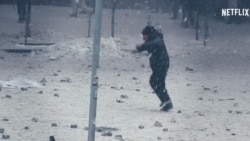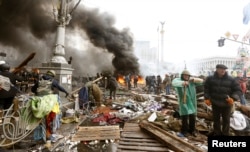In the bitter cold winter months between November 2013 and February 2014, hundreds of thousands of Ukrainians — sometimes up to a million — gathered in Kyiv's Independence Square, or Maidan, and other central locations in the city demanding a break from Moscow's orbit and a European future for themselves.
Those moments in time are captured expertly in the Oscar-nominated documentary Winter on Fire, by filmmaker Evgeny Afineevsky.
Afineevsky chronicles the massive mobilization of Ukrainians against a regime they saw as authoritarian and corrupt, capturing the protesters' bloody clashes with the government's elite riot police force known as the Berkut.
The protests began on Nov. 21, 2013, when President Viktor Yanukovych reversed himself and refused to sign a long-anticipated association agreement with the European Union that would have put the country on a path of reform and, Ukrainians hoped, a more prosperous future. Instead, he opted for continued economic and political ties with Russia.
Men, women, and even children rebelled against the move and called for Yanukovych to step down. What followed were weeks of protests that culminated in late February 2014, when Yanukovych fled the country for safe haven in Russia.
Some one hundred protesters were killed and countless others wounded in violent clashes with the Berkut.
"I'm against Yanukovych." said 12-year-old Romka in the documentary. "He's not good for us as a president. His Berkut beat a woman in front of my eyes. They beat girls, they beat boys. They even beat me."
Calls for change
As the protests turned violent, filmmaker Afineevsky captured a grim scene of the Berkut descending on unarmed civilians, beating them and shooting at them indiscriminately.
"At that particular moment," he recalled, "no one was thinking about danger. All of us were thinking how to document every second and how to preserve this history."
Despite the violence, the bitter cold and the casualties, the protesters endured.
What kept them going, they said, was unity. At a local monastery, priests offered sanctuary to the wounded, and medical personnel contributed supplies and services.
Afineevsky said he would not have been able to document the unraveling of Ukraine's government without the help of social media and multimedia. Eyewitnesses in Kyiv were in touch with him and his crew throughout the 93-day ordeal, he said.
"I started talking to the filmmakers, professionals and non-professionals who'd been there,” Afineevsky said. “Because every person who had some vision or who had some piece of equipment — and I had usage of DSLRs [digital single-lens reflex cameras], camcorders, cellphones, GoPros, Tablets, every possible technology — was helpful for us."
Afineevsky's Winter on Fire is a living testimony of a people's will, and presents yet another example of how civic unity and sacrifice can force momentous change.













